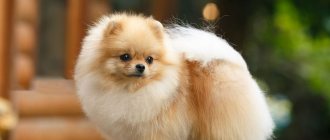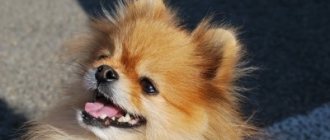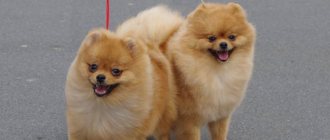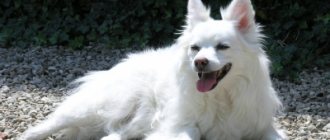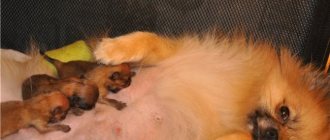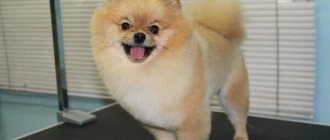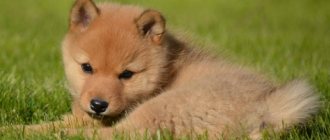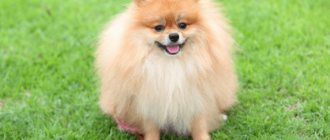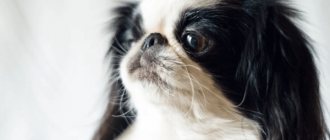Origin of the breed
The ancestors of the “Japanese” are considered to be the German Spitz or the short Samoyed husky.
The first representatives of the breed were shown at an exhibition in Tokyo in 1921. Breeders devoted the next 10 years to the new breed. To improve it, white dogs of the Spitz family were crossed, which were brought to Japan from all over the world. The final stage was crossing with the American Eskimo Spitz.
In 1948, the Japanese Kennel Club adopted a breed standard. Two years later, elegant fluffies gained popularity. But international recognition came to them only 14 years later.
Choosing a puppy
If in the future the owner plans to take the pet to exhibitions, you should take a closer look at the boy - the dog, as a rule, has more lush and thick hair than the girl. By the way, it is at demonstration performances that you can take a closer look at experienced and reputable breeders from whom you can buy a puppy.
An “Asian” should be purchased at an age of more than 2 months, since a puppy that is too young cannot easily see its exterior features. The Japanese Spitz should not be angry or growl when a stranger appears. If a potential candidate shows such habits, it is better to refuse to acquire him.
The cost of puppies is as follows: 35 thousand - 50 thousand rubles.
Description of the breed
Appearance
The Japanese or Dwarf Spitz is a small dog with thick white fur and a pointed, fox-like face.
They have a dense constitution. Despite their small size, these four-legged animals are harmoniously built. Although Japanese Spitz are popularly called dwarf, adult dogs quickly outgrow the “mini” size. The height at the withers reaches 40 centimeters. Weight ranges from 5 to 10 kilograms. Boys are usually larger than girls and have larger facial features and thicker fur.
Head and muzzle
Fox muzzle
The head is proportional to the body. The cranial part widens towards the back of the head, and the rounded forehead protrudes moderately.
The transition from the forehead to the muzzle, which resembles a fox, is noticeably pronounced. It ends with a small coal nose. Thin lips with black edging fit tightly to the jaw. This makes the dog appear to be smiling. Small teeth are located close to each other. The bite is correct, scissor-shaped. The eyes are medium-sized, regular almond-shaped. Due to the very dark color of the iris, the pupil is not visible. Eyelids black. The ears are shaped like triangles, set high with a slight slope.
Frame
Strong build
This elegant dog has a fairly strong build. Due to its proportions, it has the outline of a square.
The height of the body is related to its length as 10:11. The muscular neck goes into a clearly visible withers. The back is straight and short, the loin is wide with a sloping croup. The chest is deep, the ribs are convex, the stomach is tucked. But this is not noticeable because of the fluffy fur. The limbs are smooth and muscular. In the stance, the hind legs are wider apart than the front legs. The dog has strong, fleshy black pads. The claws are also painted black. The tail is covered with long hair and carried over the back. According to the standard, the tail may be slightly lowered towards the hip.
Wool
Thick coat
The coat consists of two layers: a dense, soft undercoat and straight, moderately hard guard hair.
The hair on the face is short. But the neck is covered with a lush collar of long wool.
Color
Sprinkles of a different color in the coat are a serious fault.
The Japanese Spitz has a standard white coat and undercoat color.
Features of character and disposition
This friendly, energetic dog needs constant human contact.
Personality: cheerful.
A representative of the breed will be an ideal family pet, as it is obedient and will withstand the pranks of a small child without causing harm in return. He will make friends with any domestic animal. The “Japanese” will be a brave and attentive watchman. At the same time, the dog does not create unnecessary noise. This is the difference of the breed.
The character of the Spitz and the peculiarities of its upbringing
Despite its size, the character of the breed is characterized by sufficient courage and restraint. If the Spitz is cowardly, makes a lot of noise and is even more aggressive - these are obvious defective signs that can be used to reject a specific representative. The dog is very active and friendly. Pets need constant communication and participation - they do not tolerate loneliness very well. They love to play and are good with children.
Spitz are quite energetic both outdoors and at home; they love to walk. When a stranger approaches, they bark, but do not make too much noise and do not show obvious aggression. Despite the fact that Spitz dogs love to walk, they do not require particularly long runs. It is allowed to keep both in a country house and in a city apartment, but with constant stay indoors - they will not tolerate loneliness on a chain. Pets are very nimble and mischievous, especially in the first year of life.
During training, a certain amount of persistence is necessary because the dog may reduce everything to a game and not learn the command. At the same time, the Japanese’s intelligence is quite high - 10-15 repetitions are enough for him to learn the command. The result should be reinforced with a treat - the Spitz is very responsive to complementary foods.
Japanese Spitz are very sociable and cheerful dogs.
Interesting fact. The Spitz is an exclusively domestic dog and is not at all intended for hunting. For animal lovers, this is a tangible advantage, because the Japanese get along well even with same-sex dogs and cats.
Breed defects
Drop ears are a breed defect.
Any difference from the standard is considered a breed defect.
For example:
- snack or undershot;
- double curled tail;
- noisy and cowardly dogs.
Vices for disqualification include:
- drooping ears;
- tail that does not lie on the back.
Boys are checked for the presence of two well-developed testes.
How to care, hygiene
Conditions of detention
The dog needs active walks.
Representatives of the breed are not afraid of cold weather, but it is better to keep them at home. This harmonious and elegant dog feels comfortable both in an apartment and in a private house. Being close to a person is vital for these furbabies, but sometimes they can be walked without a leash.
Learn more about American Eskimo Toy Spitz.
Despite their playful disposition, representatives of the breed are quiet at home and do not cause trouble. In addition, they are distinguished by their cleanliness, so even a novice dog breeder can handle the care. The “Japanese” dog can be trained to use a litter box, but this does not cancel out walks twice a day. One walk should be devoted to outdoor games. This provides moderate exercise for the dog.
Training your four-legged companion will not take much time. It is enough for the dog to learn the basic commands.
Shedding and grooming
Brush your dog when shedding.
A thick coat requires simple grooming. Your pet's snow-white hair will cause a little trouble during shedding in spring and autumn.
In addition to a special massage brush, you can use a slicker brush. The coat should be brushed at least twice a week. This will prevent the formation of tangles. Particular care should be taken to comb the fur under the belly and armpits. These cute dogs do not smell like a dog, and their white coat retains its ideal appearance for a long time. Wool is covered with natural impregnation, to which moisture and dirt do not stick. This deprives the owner of the “Japanese” of many troubles.
Bathing
The Japanese don't like to swim.
These cute creatures are not fans of various hygienic activities.
While the Japanese Spitz is still a puppy, it needs to be trained to perform grooming procedures. Wash the dog once a month. Stock up on a special bathing product at the pet store.
Our shampoos and soaps can dry out your dog's sensitive skin or cause allergies.
After bathing, apply a special balm. It will make the fur more shiny and protect it from tangling. Then dry your pet's fur with a towel. Dried hair should be combed with a special comb. Weekly teeth brushing and gum inspection are required.
Eyes and ears
Up to a year, special care is needed.
The eyes of the “Japanese” are particularly sensitive. In puppies under one year of age, they often become watery.
They are washed every day with a cotton pad or napkin moistened with boiled water. If during a walk a speck gets into your pet's eyes, rinse them with a decoction of chamomile. If necessary, your veterinarian will prescribe eye drops. Every week, inspect and clean any excess wax from your four-legged furry's ears with a cotton swab.
Claws and paws
The strength of the claws can be tested on things.
Paws are wiped after returning from the street. The fur between the pads is trimmed as it grows.
The claws of your four-legged companion are trimmed every month. They do this with a claw clipper. If you can't do it yourself, a professional groomer will help you.
Ticks and fleas
Prevention will prevent the appearance of ticks and fleas.
If you neglect to care for the thick fur of your four-legged friend, fleas may appear.
Therefore, prevention needs to be done regularly. Pet stores have plenty of drops, sprays and other products that will help get rid of fleas or are suitable for prevention. As a measure to prevent ticks, you should carefully examine your pet after walking in the forest or tall grass.
Worm prevention
Increased appetite in the “Japanese” is not always a symptom of worms, since dogs are prone to overeating.
You should contact your veterinarian if your pet has problems with digestion or lethargy. To prevent worms, your dog needs to take an anthelmintic every three months. The veterinarian will select the necessary drug.
Features of maintenance and care
The Japanese Spitz is designed to live in a house or in a city apartment. The small size of the dog allows it to be kept in a small room. It is prohibited to keep it on the street, in an enclosure, and especially on a leash.
Representatives of this breed do not have an unpleasant specific dog odor, so there is no need for frequent bathing. If the pet gets very dirty during a walk, then special shampoos for white fur are used for washing, as well as tint balms, which will visually make the fur brighter and snow-white.
To quickly make the coat whiter, experienced breeders use special grooming powders for bleaching. This method helps to maintain a chic color on the eve of exhibitions or dog shows.
Grooming
The owner's main concern is caring for the Japanese Spitz's coat. At first glance, it seems that it is difficult to keep a dog’s snow-white coat in a presentable condition. However, breeders claim that caring for him is quite simple.
The Japanese Spitz is a very clean animal by nature. Its fur does not get tangled, so it is enough to brush your pet twice a week.
During seasonal shedding, more frequent and thorough brushing is required. This will help to avoid excess hair in the house, and also contributes to the speedy renewal of hair.
Grooming an Asian Spitz is not a mandatory procedure. Preference is given to a natural look. Removing excess hair is done for hygienic purposes.
Particular attention is paid to the paws and interdigital space. An overgrown paw looks untidy; pieces of dirt can accumulate there, which can cause pain for the dog when walking.
Take special care to trim the area around the anus. If the owner of a Spitz does not have experience in grooming dogs, then it is better to turn to professionals - groomers.
Walk
Japanese Spitz do not need active physical activity. To meet natural needs, short walks in the morning and evening are sufficient. But the “Japanese” will also not refuse a leisurely walk in the park area; he will happily frolic in the company of other dogs.
Long walks can tire a dog; the owner should monitor the pet’s condition. Over time, it will become clear how long the “Japanese” is ready to walk.
From an early age it is necessary to accustom your pet to wearing overalls. This will eliminate the problem of washing the whole fluffy after a walk in slushy weather.
Feeding
What should I feed my Asian Spitz - dry food or natural food? The owner decides based on his financial capabilities and availability of free time.
Some breeders of the breed are inclined to believe that only natural food is suitable for Spitz dogs. Others believe that pelleted feed fully provides the animal with the necessary nutrients and vitamins. Japanese Spitz are not picky eaters. Any food is accepted well.
For the proper development of a small Spitz, it is important to follow a diet. From the very beginning, you need to adhere to the rule: do not give your pet any other food between feedings. Otherwise, the “Japanese” will get into the habit of begging for tasty food from all family members, and this leads to overeating and obesity.
If you decide to feed your dog dry food, you should carefully study the brands offered. Holistics and premium luxury foods have proven themselves well.
It is recommended to avoid dry food that uses beet pulp in its production. It gives the “Japanese” fur an unsightly pinkish tint.
Natural nutrition should not be confused with food from the master's table. You should not feed your Spitz scraps.
List of prohibited products:
- Confectionery.
- Tubular bird bones.
- Smoked meats.
- Salted and pickled foods.
- Fried food.
- Fat meat.
List of permitted products:
- Lean meat (if raw, be sure to pour boiling water over it).
- Lean sea fish, previously separated from bones.
- A boiled chicken egg once a week.
- Cereals (exception - semolina).
- Vegetables and fruits, fresh and thermally processed.
To prevent vitamin deficiency, multivitamin therapy is carried out twice a year.
Diet and feeding regime
Feeding from the table is prohibited.
Proper nutrition is the key to the health and longevity of your four-legged friend. Ready-made super-premium food is suitable for feeding. They are balanced and correspond to the age and health characteristics of the four-legged animal.
If you are going to prepare your own food, use beef or veal as a base. Twice a week you can treat your pet to beef offal or boneless sea fish. Rice and buckwheat are excellent sources of carbohydrates. Fermented milk products are given regularly. You can add vegetables to your diet. You need to give your dog clean drinking water.
Diet plays an important role. The number of feedings depends on the age of the dog and ranges from 5 times a day for a three-month-old puppy to 2 times a day for an adult dog. You should not allow snacks between meals. Due to the gluttony of the “Japanese”, regular overfeeding leads to obesity.
Feeding “from the table” is strictly contraindicated.
Frequent illnesses and problems
- Long hair encourages the appearance of fleas.
- Eye diseases if not cleaned on time.
- Vulnerable knees, prone to displacement.
- Genetic problems, if not all individuals in the family were standard.
Dogs can memorize hundreds of words
The average dog is as trainable as a human child and can learn between 200 and 500 words. Moreover, the dog can learn the basics of mathematics, such as learning to count and order numbers in ascending order.
Collies were once considered a vicious breed
Collie was once considered a vicious breed of dog, mainly due to the fact that this breed is of Scottish origin, and the Scots were considered uneducated and poor people. Collies became a popular and prestigious breed in the 19th century when Queen Victoria became a fan.
A dog is the first animal to orbit the Earth
Laika became the first living creature to orbit the Earth. Her flight on Sputnik 2 took place in 1957. Although she herself died during the flight, her daughter, Pushinka, gave birth to 4 puppies from the terrier Charlie, whose owner was US President John F. Kennedy.
Spitz diseases: risks and prevention
“Japanese” are practically not susceptible to genetic diseases, so the breed is considered safe. Representatives of the breed are at risk for the following ailments:
- conjunctivitis (inflammation) of the eyes;
- thyroid diseases;
- epilepsy;
- dysplasia (deviations in the structure) of the hip joint.
A veterinary clinic can conduct a genetic test to determine whether the animal is a carrier of the damaged gene or not. Vaccination is necessary for a puppy to prevent various infectious diseases. Annual vaccinations will improve your pet's health.
How to choose the right puppy
Buy puppies from kennels
A photo of a fluffy Japanese Spitz puppy instantly lifts your spirits. To acquire a four-legged friend, you will have to work hard.
Although the breed is not widespread in our country, nurseries have already appeared that breed “Japanese”. If you want to save money and are not afraid of getting a mixed breed or a puppy with genetic abnormalities, you can look for advertisements for sale.
What to pay attention to
You should start by examining your parents. Both must meet the standard not only in appearance, but also in behavior. The adult dog is friendly but wary of strangers and does not bark without good reason. Then we move on to the puppies. The puppy is inquisitive, playful, and constantly on the move. He should have a cool nose, a soft belly, healthy skin and snow-white fur. The nursery must provide you with a pedigree and vaccination passport.
Cost on Avito
If the Japanese Spitz has won your heart, and everything about the breed has already been studied, all that remains is to decide on the purpose of purchase. You need to decide whether the dog will participate in exhibitions or not. The more hopes you place on a future champion, the more expensive he is. The price for one puppy on Avito ranges from 10 to 60 thousand rubles.
How much do Japanese Spitz puppies cost?
The price of a Japanese Spitz puppy has a wide range. The more titled the parents and the more famous the kennel, the more expensive the dog will be. Average price (in rubles) 50,000. Puppies whose purpose is exhibition or breeding are the most expensive. Their price is from 80 thousand rubles and above.
You can buy a pet for the soul, without claims to championship titles. Japanese Spitz puppies that show signs of being rejected cost less. Through private advertisements or at the poultry market, they are sold for a symbolic price - from 2000 to 5000 rubles.
Owner reviews about the breed
The first owner of a Japanese Spitz in Russia was trainer Nikolai Pavlenko. He described his experience this way:
This was my first Japanese Spitz dog. We have had and still have dozens of dogs... All of them are loved. And Rikki was human. I was in seventh heaven. Nothing but happiness and joy from communication...
Alena Voronetskaya, Spitz breeder (kennel “Sakura Show”):
I didn't have dogs, only ordinary "noble" cats. But, like many, I dreamed of a dog. I really liked Samoyeds, but they are too large for an apartment. I also liked Pomeranian Spitz, but that was also not the case... And one day I saw a Japanese Spitz on the Internet - and the mosaic came together: white, fluffy and Spitz.
Eva Pavlovna:
We gave this cute creature to my sister for her birthday, but after seeing how cheerful, funny and playful this baby is, we decided to get one for ourselves. They have a certain innate aristocracy, they are very smart, clean and don’t shit anywhere (about going to the toilet, they somehow immediately found a common language with him).
If you get a puppy, you need to remember about basic care, in addition to feeding (we feed with good food, which was recommended by the breeder). We clean the eyes daily, check the ears once a week, carry out prevention against worms and fleas (once every 3 months), vaccinations according to age.
The only negative, in my opinion, is the price of a purebred puppy, but believe me, it’s worth it!
Related breeds
The Spitz family is like a colorful kaleidoscope. The size of representatives ranges from dwarf to those whose height at the withers reaches more than 50 centimeters. Spitz breeds include:
- German;
- Pomeranian;
- Finnish;
- American Eskimo;
- Italian Spitz Volpino;
- Eurasian;
- Greenlandic;
- Karelian-Finnish Laika;
- Karelian bear dog or Karelian bear husky.
Spitz varieties
The peculiarity of the Japanese Spitz is that it is suitable for any dog owner. These dogs are able not only to cheer up, but also to bravely protect the owner. A mischievous fluffy dog with a sharp mind will be an ideal family pet or a wonderful companion and understanding interlocutor for a lonely person.
Character and training
The purely family characteristics of the breed are justified by years of selection and the original goals of the breeders. Japanese Spitz puppies already at 1–2 months show pronounced companionship skills and gravitate toward human society. The first nuance follows from the main characteristic - four-legged animals are very loyal and dependent on the owner, it is not advisable to leave them on their own for a long time during the day or during vacation.
Be careful not to “tip the scales” in the other direction. The dog is not decorative, it has no place on a pillow or sofa , just like any dog. By preparing a personal place for the puppy in advance, you will solve some of the problems with “occupying” furniture, which tailed dogs are prone to.
Note! Aggression is not typical for the breed, but when it comes to protecting the owner, the behavior of the four-legged dog is quite unpredictable. Hypothetically, the Japanese Spitz is a rather serious, agile competitor with a strong and deep jaw.
In relation to the family, dogs are more than friendly, they are also tolerant of their four-legged cohabitants. The Japanese Spitz is an excellent pet for a family that has or plans to have children. Despite the pronounced affection, representatives of the breed are not prone to jealousy.
